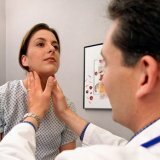Varieties of superficial candidiasis
 To date, doctors know a lot of different skin diseases. One of these diseases is superficial candidiasis. Candidiasis can be acute and chronic, and it can also be infectious-allergic. Candidiasis occurs as a result of exposure to the body of a special fungus of the genus Candida.
To date, doctors know a lot of different skin diseases. One of these diseases is superficial candidiasis. Candidiasis can be acute and chronic, and it can also be infectious-allergic. Candidiasis occurs as a result of exposure to the body of a special fungus of the genus Candida.
Candidiasis can develop primarily and secondary, against a background of a different disease. Doctors distinguish the following stages of infection: attachment of the pathogen to the skin or mucous membrane, reproduction at the attachment site, the growth of bacteria with a violation of the barrier functions of the mucosa or skin, the penetration of the causative agent into the blood.
As a rule, candidiasis occurs because of weakened immunity. Also, the fungus can penetrate through damaged tissue covers. Often, wounds, burns, dentures, increased sweating increase the risk of infection with fungus. Diseases associated with metabolism( diabetes, obesity, thyroid disease, iron deficiency, zinc, and the like) can trigger the disease. Severe diseases that lead to a decrease in immunity, chemotherapy and radiation therapy, antibiotics, blood diseases, tumors, surgical interventions and other factors can affect the development of candidiasis.
Candidiasis variants
There are several varieties of superficial candidiasis: candidiasis of mucous membranes, smooth skin, red border of the mouth and corners of the mouth, onychia, paronychia.
Candidiasis of the mucous membranes
Candidiasis can occur on the mucous membranes of the mouth. Still it or him name a thrush. Thrush is often found in newborns. In adults, candidiasis on the oral mucosa manifests itself in the form of gingivitis, stomatitis, and cheilitis. It often occurs with severe dental diseases.
When candidiasis on the mucous membrane of the tongue, cheeks, gums, soft palate appears white coating, resembling a crumb. If the disease is not treated, the plaque forms a continuous film. In the beginning, the film can be easily removed, but when it exacerbates, it becomes denser and becomes dirty. After its removal, the damaged surface begins to bleed.
Women often have thrush, which affects the mucous membranes of the vagina. On the walls of the vagina and cervix uteri formed a grayish white coating, which also resembles the curds mass. Thrush is accompanied by itching and burning.
Yeast lesions of the mucous membranes of the urethra and bladder are much less common. Yeast cystitis can be detected only with cystoscopy. On the mucous membrane of the bladder appears plaque in the form of crumbs. Also, the disease can be detected by examining urine.
It is not difficult to distinguish candidiasis from other diseases for an experienced specialist. It has characteristic specific features. With candidiasis, the plaque from the affected mucous membranes is easily removed.
Yeast lesions of the corners of the mouth
Zaeda almost do not differ from streptococcal lesions. In the corners of the mouth painful cracks and erosions are formed, which are surrounded by whitish edges or crusts. With prolonged existence, the skin around the cracks is infiltrated.
Yeast lesion of the red border of the lips( cheilitis)
Yeast cheilitis is rare. Most often, it manifests itself simultaneously with lesions of the corners of the mouth. The red border of the lips is slightly hyperemic, flaky, slightly swollen. To make a diagnosis, it is necessary to conduct a culture or microscopic examination.
Yeast lesion of large folds( yeast intertrigo)
Yeast intertrigo is most often observed in the interannual folds, in the groin-scrotal area, in the axillary cavities, in the folds of the abdomen and under the mammary glands. Often the disease is very full people. The disease begins with small rashes, surface vesicles, which are opened and then eroded. Erosions quickly expand and merge with each other. In case of exacerbation, the entire affected area is covered with erosions, which cause a lot of discomfort to the sick person. The erosion surface is dark red and slightly moist. In the depths of the crease, cracks and accumulations of whitish gruel-like mass often appear. Around the main focus is a rash of fresh vesicles.
Interdigital candidiasis of brushes
Interdigital erosion of brushes is one of the most common forms of yeast lesions. Most often it occurs in women who are engaged in housekeeping. In one of the interdigital spaces there is maceration of the stratum corneum. The skin, in the area of the fold and the nearest lateral surfaces of the fingers, is slightly thickened by the swelling of the stratum corneum and whitens. Then the macerated stratum corneum exfoliates, and in its place dark red moist erosion is formed, surrounded by a white border. Around the erosion often appear rashes in the form of vesicles. The patient is troubled by itching and burning.
Interdigital candidiasis of feet
This type of disease is most often observed in men. Erosions are localized not in one place, but in several, often in all interdigital spaces. At the initial stage the stratum corneum develops, and the patient does not notice it. At the second stage erosions appear, which first spread in the depth of the folds, and then on the lateral and plantar surfaces of the fingers. Erosions of dark red color with a cyanotic shade. They are painful and itch, so the patient feels a strong discomfort. If the disease is not treated, lymphadenitis and lymphangitis may develop.
Candidiasis of nails and nail ridges
Yeast lesions of nail ridges are observed in women more often than in men. Often occurs with interdigital erosion. Most often the nails of the third and fourth fingers of the hands are affected. The disease begins with the defeat of nail rollers. Rear, and then lateral cushions swell, turn red and become painful. The nail peel quickly disappears. When pressing on the posterior nail roller, quite often from under it flows a little pus. Later on, a small peeling or painful cracks appear on the surface of the nail roller. If you do not start treatment on time, the nail plates in the nail and lateral rollers of the nail are affected. In this case, the nail plate becomes brownish gray and becomes turbid, and the lateral edges begin to peel off. A complete exfoliation of the nail plate is possible.
Candidiasis of the skin outside the folds of
Yeast lesions outside the skin are not common and have a diverse character. For example, in infants, very often simultaneously with lesions of the folds on the skin of the trunk, buttocks and extremities, rashes in the form of spots of different sizes can be observed. The spots are bright red and are covered with a shiny surface, or erosive. The skin around the spots flakes off and small rashes appear in the form of bubbles. Similar lesions can occur in adults, most often in areas of the skin that have been subjected to prolonged and frequent compressions and the application of moist dressings.
If a woman is breastfeeding a crumb with a thrush in her mouth, a woman can develop a yeast defeat of the areola in the form of sharply delimited pink, slightly flaky and eroded puffs. Cracks are often formed at the base of the nipples.



